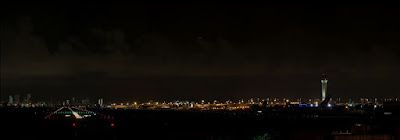When I flew for PBA, I flew my Cessna 402C all over southern New England. I would show up at 7AM and be on reserve all day. Dispatch would call and say things like "Run over to Nantucket and fly 7312 to Hyannis," and off I'd go. We had some regular runs, but mostly you just went where they said.
It was New Year's Eve and we were done flying. My roomate and I were driving to Hyannis for the New Years Eve party when we stopped by the airport in New Bedford where we were based. A guy was at the counter and asked us, "When's the next flight to Martha's Vineyard?" We explained that the last flight had already left. The manager said he'd suggest the ferry but they'd stopped running too. This guy said he absolutely had to get there, any other ideas? We called the charter service down the road. No, all their pilots were gone for the night (probably at the party in Hyannis). I said wait a minute and called our dispatch office. I explained the situation and asked what would they charge for a charter for this guy. "I don't know, what seems fair?" he asked. I said something like, "$150 ought to do it," and he said, sure, go ahead. We were very casual about our flying business at PBA. So my roommate and I went out to the plane, preflighted quickly and took off for the 15 minute flight to the Vineyard. When we landed he was very grateful and gave us each $50. Wow! Until then we'd been broke and didn't even have gas money to get to Hyannis. So we flew home feeling pretty rich.
On Monday mornings we would often fly nine state workers over to the Vineyard where they would work all week, then we'd fly them home on Friday night. These were big guys, with lots of heavy tools. Being based in New Bedford I was usually the guy who flew them. So one night I run over to the Vineyard and nine husky dudes climb on. We fly back in the winter darkness to New Bedford. It's cloudy, pretty crummy weather, all foggy and wet snow. In the clouds I get vectored to the final approach course for the ILS to runway 14. Flaps to approach, slow to 130 knots. At the outer marker I put the gear down and drop full flaps, slowing to 110 kts. Suddenly there's this loud BANG! under our feet. The front seat passenger jumps. What happened was the cable to the left flaps broke. This caused the left flap to immediately retract fully. So suddenly I have the right flap full down and the left flap full up and we start rolling left. I crank in all the aileron I can but it's still rolling. At the same time I undid whatever I just did. I grab the flap handle and put it back up. This makes the right flap retract. As it does, the rolling stops at around 60 degrees of bank, just as I was REALLY getting worried. You know, when the first thing happens you think "Oh crap!" and then when it gets really worse you think "Oh fuck me!" I was just past the second part when she started to roll back upright. I quickly corrected back to the right to the ILS and continued on in. Didn't say anything to the tower. What would be the point? I landed with flaps up, which is a simple thing, and taxied in. At the gate I shut down the engines and it was dead silent, no one moved. Then the supervisor in back says in a very gruff voice, "Hey Cap'n, what was that noise?" I said oh it was nothing really, just a cable broke I think. (just something that almost killed us all). He thought about it a moment, and then said "Well, good job," and everyone got up and left.
I was alone after that and just went about finishing up my duties. Then I took off my stripes and hat and went into the airport bar (our favorite haunt) and ordered a beer with a shaking hand. I don't remember it shaking, but I'm sure it was. Undoing what I had just done, putting the flaps back up, proved to be the lifesaver, and after that it became my rule #1. Unfuck yourself. Found out if the other cable had snapped, to the right flap, I would have been screwed. The flap indicator only sees the right flap and if I had selected flaps up with the left flap down it would have looked at the right flap and seen it was up and done nothing. Lucky for me it was the other way around. That of course is life. One cable or the other. Life or death. In all my years of flying, that's probably as close as I ever came to "buying the farm". Well, OK, there was that one night in Minnesota.....


























